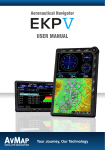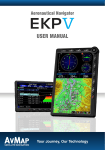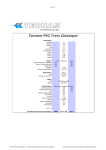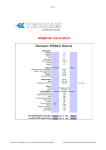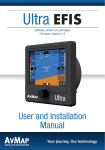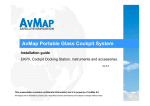Download USER MANUAL
Transcript
Aeronautical Navigator USER MANUAL Update Software version V1.6.069R Your Journey, Our Technology INDEX Navigatore Aeronautico AvMap EKPV 1. LEARN BEFORE USE 4 I. II. III. IV. V. Safe temperature range Battery and power source recommendations Warning Unit setup Powering Up the unit 4 4 4 5 5 2. 3. Initial Settings General controls to operate the unit 6 7 I. II. Button, Joystick and Wheel controls EKP V Views 7 8 4. 5. 6. 7. 8. GPS Page Main Menu System Setup Map Setup Explore the Map I. II. III. PAN mode Map information and cursor menu MODE menu on Map 9. GoTo - Direct Navigation I. II. III. Cursor Airport Search Other objects I. II. III. IV. V. VI. VII. VIII. IX. X. How to create, delete or reverse a FP How to assign a name to a FP How to add, delete and show-on-map a Waypoint How to change the WP order in a FP How to activate and navigate a FP How to change the WP INFO visualized in the WP List Area How to show/hide the FP Vertical Profile How to activate the Airspace Check function How to create a SAR (Search and Rescue) FP How to select an approach 10. Tracks 11. Flight Plan 12. Approach Plates 13. EKP V Simulator 14. Tools 15. Profiles Appendix A: NMEA Data Transfer 8 9 9 10 13 13 13 14 14 14 14 16 16 17 18 18 18 19 19 19 19 19 19 19 19 21 22 26 29 Aeronautical Navigator AvMap EKPV 1. LEARN BEFORE USE I. III. Warning Safe temperature range DANGER: do not operate EKP V beyond the operating temperature range. Temperature Operating temperature Storage temperature* MIN MAX - 20° C / - 4° F 60° C / - 140° F - 30° C / - 22° F 80° C / - 176° F *without battery DANGER: do not store EKP V beyond the Storage temperature range. Remove the battery before storage. II. Battery and power source recommendations EKP V is provided with a Li-Ion rechargeable battery. The battery compartment is in the back side of the unit, under the battery cover. DANGER: Never operate or store EKP V without the battery cover in place. DANGER: The battery could explode in case of improper use or short-circuit. Battery is recharged connecting EKP V to a power source using the cigarette lighter cable or the wall charger. DANGER: Use only the original cables provided in the box to power EKP V. Full charge of battery requires about 6 hours. EKP V can be operative while charging; in this case the full charge of battery could take up to 12 hours. ATTENTION: If the battery is completely discharged, it could be necessary to remove it and then to power up the unit on external power. Once the unit is running re-insert the battery. 4 - Quick Manual The electronic cartography displayed by the EKP V is not certified for use for VFR or IFR flights. The EKP aeronautical GPS navigator is meant as an aid to VFR navigation and is not a substitute for official PUBLICATIONS, NOTAM, BRIEFINGS and AERONAUTICAL CHARTS that must be in any case carefully consulted before and during any flight. The information provided by the EKP is GPS based information which is only intended to supplement official charts. All critical flight information is presented for reference only and must be verified by the user. The EKP is not a substitute for on-board instruments. The sector MORA values provide a minimum 1000 foot clearance above terrain and physical obstructions. Terrain and obstacle data provided are only to be used as a general reference to your surroundings and as an aid for situational awareness. Street network information has only been provided with the purpose of reference during flight and should be used with caution. The altitude shown by EKP V is the geometric distance from the sea level based on GPS data. XM Weather data is meant to show atmospheric disturbances in order to select alternative routes, and not to guide you through the bad weather conditions. The Global Positioning System (GPS) is a space-based global navigation satellite system operated by the U.S. Government, which is solely responsible for its accuracy and maintenance. EKP V has an internal data logger where the flight data is recorded. Data logger is not accessible without disassembling the unit. EKP V chart and database data are provided by third parties, included but not limited to Navteq® and Jeppesen®. Aeronautical Navigator AvMap EKPV Cartographic data loaded in the EKP V can differ from reality. The pilot in command assumes total responsibility and risk associated with the use of this device and remains solely responsible for flying in safe conditions. AvMap disclaims any liability deriving from an improper use of the device, in a way that may violate the flight and navigation rules, regulations and safety. IV. Unit setup 1. Open the battery compartment 2. Insert the Micro SD, if not already inserted 3. Insert the battery 4. Close the battery compartment door 5. Rotate the GPS antenna to the maximum sky visibility position. 6. Connect EKP V to a power source for battery charging: 6.1 Connect the cigar lighter cable with the label face up to the EKP V side connector, or 6.2 Connect the USB cable to a PC (slow battery charge), or 6.3 Connect the USB cable to the wall charger. 7. The unit will automatically switch on. V. Powering Up the unit The EKP V can be powered up both running on battery or on external power. When running on battery to power up the unit press once the POWER button. When the external power cable is connected either with battery inserted or not inserted the unit will automatically switch on. In the power up phase two consecutive splash screens will appear. After a few seconds the second splash screen will be replaced by the Warning page. To move to the map press the joystick (ENTER). The EKP V has been conceived to be always ready to use through a STANDBY functionality which can be set by the user. The user can set a time interval from a minimum value of 5 min to a maximum of 120 min to enable the function. The user can put the EKP V manually in STANDBY by pressing the PWR button and release the PWR button before the countdown. To turn off the unit completely the user needs to keep the PWR button pressed for more then 3 seconds When the navigator is in STANDBY, pressing POWER button it is possible to resume the unit on the map page. It is suggested to not Quick Manual - 5 Aeronautical Navigator AvMap EKPV power off the unit and to use the STANDBY functionality. After 8 hours of inactivity the unit will power off autonomously. 2. Initial Settings When you power on EKP V for the first time, you need to choose some basic settings, in order to start to use the device. Language When you power on the device, you need to choose first the language. The default language is English. If you want to change language: 1. Scroll down the items until you will find the preferred language (see sample image) 2. Push the joystick to select it. Scroll down the list to select Continue and 6 - Quick Manual push the joystick to go to the next page. In the next page, you need to choose (see sample image): Regional settings Choosing the regional settings, you select some basic settings to be used on your device. You can choose between American and Other. Choosing American, you select the following parameters: • Temperature: F • North Reference: Magnetic • Local Time Difference: -06:00 • Date Format: MM/DD/YY • Objects overlap: ON • American Selective Display • American POI View Aeronautical Navigator AvMap EKPV 1. Push the joystick to enter in the menu 2. Scroll the joystick up or down to increase or decrease this difference 3. Push the joystick to confirm and exit. Display orientation You can choose between vertical orientation and horizontal orientation. In order to set the preferred orientation, choose the item and push the joystick. After you have chosen all the required settings, select the item Continue and push the joystick to go to the Warning page. These settings are automatically saved for the next use. You can modify these settings in every moment, using the correspondent menu. Note: Your settings are stored in the SD card in the active user profile. Using another SD card, your settings will be lost. 3. General controls to operate the unit Choosing Other, you select the following parameters: • Temperature: C • North Reference: True • Local Time Difference: +01:00 • Date Format: DD/MM/YY • Objects overlap: OFF • European Selective Display • European POI View In order to use the device in Europe, you need to choose Other. When the unit is used in North America you need to choose American. Local time difference You need to set the difference between the time of the country where you are using the EKP V and the UTC time. To set this difference: I. Button, Joystick and Wheel controls F1 – Provides quick access to several function at user choice NEAR – Lists nearest objects MENU – Opens Main Menu page MAP – Goes back to the Map ESC – Escapes from one menu page or menu item to the prior menu GOTO – Activates navigation to selected object FP – Opens Flight Plan Menu CYCLE – Toggles between various map presentations MODE – Change display mode from Navigation display, EFB, EFIS and Standby mode Quick Manual - 7 Aeronautical Navigator AvMap EKPV POWER – Turn On/Off, Standby and controls brightness (press once) JOYSTICK – Used for PAN the map and when pressed as ENTER WHEEL – Used for Zoom In/Zoom out on the map and for navigating in the Menus II. EKP V Views The EKP V software is made by two main views: Map and Menu. The Map view is accessed pressing the map button; it contains the moving-map representation. Three different configurations can be selected by the user: Track Up, Leg Up and North Up. The Menu view is made by different pages and contains data and settings. How to operate in the Map view Move the joystick to move the cursor on the map. Push the joystick to open the cursor menu. The wheel (or knob) controls the ZOOM level on the map. How to operate in the Menu view The Main Menu bar is available on the top of the page displayed. Each page has different areas. To move to an area below the current one, move the joystick down; to move to an area above, move the joystick left or press ESC. To focus on the desired option use the wheel. To select a menu item push the joystick. 4. GPS Page To optimize the GPS antenna reception, we advise that you open the antenna and keep it lifted upon a parallel position in reference to the sky. The GPS status is displayed in all pages and 8 - Quick Manual also in the map view by the “satellite” icon. Three green bars mean a perfect signal reception, instead the icon made with a red bar and a WARNING symbol inside a triangle means that the signal is not present. To control the reception status, you need to access to System Setup menu in the main menu and select GPS Page. In this page you can see the signal level for each satellite and the constellation scheme, together with additional data regarding the reception and the position. In the EXT. GPS box, you can see the wording EXT. if you are using the external antenna, while you can see the wording DIS. if you are using the internal antenna. WARNING: Global Positioning System is a system provided and maintained by The Aeronautical Navigator AvMap EKPV United States of America Government, who is solely responsible for keeping it working. AvMap is not responsible for any possible damage, changes and calculation adjustment that could affect the data accuracy. 5. Main Menu Push the MENU button to open the main menu. In the top menu bar it is possible to choose between: - Map Setup, to change the visualization of information and objects on the map - Navigation Setup, to change the navigation parameters - Database, to operate on the database of aeronautical objects and personal data - Tools, to operate on specific function as weather, checklist, etc - Profiles, to create and manage different user settings - System Setup, to change the general settings of the EKP V - About, to check the version of system components 6. System Setup System Setup menu allows you to set several basic settings and preferences in order to customize the unit according to user needs. The orientation of the display can be set as vertical or horizontal. The language can be changed to the mother language of the user (default language is English). Regional settings can be switched between American and Other. Also other functions such as the Max Power Save mode and the Standby Timeout can be selected in this menu. Max Power save profile can be used when it is required to save battery. In this mode, display is switched off after 10 seconds since last user action or software command. Display shall switch on automatically when software detects a variation of relevant parameters as speed or when the FP approaches a waypoint where a maneuver is requested. Standby Timeout is the timeout the unit waits before moving to Sleep Mode when no user action or input is detected. F1 Button Another important feature which can be accessed through the System Setup Menu is the F1 button setup. Quick Manual - 9 Aeronautical Navigator AvMap EKPV F1 is a button that can be set up to be associated with several functions. In order to set it up: 7. Map Setup • Push MENU button and then F1 button • The list of the possible functions that can be associated with this button appears on the screen. Choose the favorite functions among the listed ones. • Push ESC button to come back to the map. The Map Setup menu is the first menu available in the top menu bar of the main menu page. In this menu it is possible to optimise the map details and information based on the navigational need and conditions. After you set up it, whenever you push F1 button during the navigation, the customized menu will be opened and using it you will able to access to all your favorite functions. If you set up only one function for this button, F1 will allow you to access directly to it, without opening a menu window. Map Visualization: This section permits to setup maps presentation, the map orientation and the auto position mode. Presentation Setup The Presentation setup menu gives you the possibility to setup 3 different map presentations. Each Map presentation is defined on Cycle 1, Cycle 2, and Cycle 3 on users preference. For each cycle you can select what map type you want to see, and at the same time for each map presentation you can choose what objects and airspaces you want to enable in that specific map presentation. Once you setup this menu you can easily change the visualization of the map by selecting the CYCLE button. Every time you touch the CYCLE button the map visualization will be modified according to the pre-defined customized cycles. On the Presentation setup you select for each Cycle the type of Map to be used: - Map : Geographic Terrestrial Background map with or without Land Elevation (Land Elevation visualization can be enabled or disabled in OBJECTS for each cycle). - TAWS : Terrain Awareness Warning System. TAWS highlights safe and unsafe elevation for an easier to read map display. TAWS 10 - Quick Manual Aeronautical Navigator AvMap EKPV is a very powerful feature that uses the separation between the aircraft and the land elevation to highlight the dangerous land elevations, allowing the map to be more easily and readily interpreted. To enable TAWS function, Land Elevation needs to be enabled in “objects” . TAWS has two settings: 500 feet Separation and 1000 feet Separation. The colour shading is based on Obstacle Clearance Height (OCH). In case of 1000 feet SEP setting all terrain with an OCH value under 1000 feet are highlighted in red, while a 500 feet SEP highlights all terrain with an OCH value under 500 feet. - Weather (only available in North America and Canada with XM WX Weather service): See chapter “14. Tools” for more information. - Sectional Charts: Only visible in the presentation menu if Sectional Charts are installed on your EKP V. Auto position Mode Auto Home The Auto Home mode is used to keep the fix position within the visible map. The map is scrolled and redrawn automatically as your position moves. A slow flashing airplane icon will indicate your current position. The airplane will be pointing in the direction of movement. Auto Home can display the map in North Up, Leg Up or Track Up. To deactivate Auto home mode press ‘ESC’ activating the cursor at the previous position Quick Manual - 11 Aeronautical Navigator AvMap EKPV or move the joystick to enable the cursor under the current fix position. Auto Zoom The Auto Zoom mode is used to keep the fix position and destination (Target) visible on the map. The map is scrolled and zoomed automatically to keep the best view possible. When this mode is active the cursor is hidden. To activate Auto Zoom mode press ‘ESC’ in Moving Map. Auto Zoom requires a position fix and an active destination point. If a destination point is not present it works as Auto Home mode. To deactivate Auto Zoom mode press ‘ESC’ activating the cursor at the previous cursor position or press the key to enable the cursor under the current fix position. 12 - Quick Manual Map Layout: In this section it is possible to configure the layout of the map page. EKP V gives the possibility to customize in detail the content of each data field and its position. Moreover, it is possible to select and display data fields both in the vertical and in the horizontal bar. Select Layout Configuration to modify the layout of the map page. There are 3 sections to configure, selecting each of them on the selecting bar on top of the menu page: Vertical Profile (VP) Permits to show or to hide the Vertical Profile during navigation. HSI window Permits to show or to hide the HSI window. Aeronautical Navigator AvMap EKPV Data fields The data fields can be hidden or shown in 4 ways; one line, two lines, three lines or one vertical column. The scheme shown in this page represents the map page. The highlighted zone is the one that you’re going to modify. To configure one of the options, scroll with the wheel selector or joystick through the options. Push ENTER to confirm the option and check the result on the scheme shown in the centre of the page. Objects: To avoid map cluttering caused by too many objects, it is possible to select which objects are shown on the map and which are hidden. When using the menu Selective Display it is possible to pre-define the visualization of different objects on different Zoom levels. II. Map information and cursor menu When placing the cursor on top of an object, an information window appears that shows some object information. To get complete information of the object, select ENTER. The cursor menu will appear from which it is possible to select: • Objects info, to visualize the information of the selected object. • Airspaces, to visualize the information of the airspaces of the cursor position. • Add to FP, to add the cursor point (Object) to the activated Flight Plan. • Add user point, to save the cursor point as user point. • Save as user mark, to save the cursor point as user point. • Show zoom lens, to see the objects 8. Explore the Map I. PAN mode If the GPS signal is available, the icon of the aircraft is shown on the map. When moving the Joystick, the cursor will appear on the map and you enter in the PAN mode, which permits you to explore the map and the shown objects. The cursor is represented by a round icon with a cross in the centre and an arrow for orientation. The orientation of the cursor is always in the direction of your proper position. When the GPS signal is missing the icon made with a red bar and a WARNING symbol inside a triangle is displayed, the cursor is shown on the map but the orientation arrow of the cursor will disappear. For zooming, touch the wheel selector and scroll from left to right to ZOOM IN or ZOOM OUT on the map. Quick Manual - 13 Aeronautical Navigator AvMap EKPV area at a closer zoom level in a separate window, which makes it easier to select an object without changing the zoom level of the map display. III. MODE menu on Map During navigation it is possible to change display mode to EFB mode (Electronic Flight Bag), PFD mode (Primary Flight Display) if the AvMap A2 ADAHRS module is connected to the EKP V, or Navigation mode to display the moving map. The EFB page provides quick information on the departure airport and the destination airport of the active flight plan, like airport information and airport Approach Plates. 9. GoTo - Direct Navigation Direct navigation to an object can be activated selecting the GOTO button. The menu permits to choose different types of destinations. In particular, from the GOTO menu it is possible to search for a specific point as destination: • • • • • • • • Cursor Airports VOR, NDB, Intersections Address POI VFR Rep. Point User point Lat/Lon I. Cursor This is the quickest way to plan a route. Search for the destination point by exploring the map with the cursor, place the cursor on the precise position (use the ZOOM level to be more precise) and press the GOTO button. The GOTO menu will appear and select Cursor. The selected position is 14 - Quick Manual now your destination and the navigation is immediately active. II. Airport Search In the GoTo menu select Airports to search the destination in the airport and airfield database. You can search for an: • ID • Name • City When you enter the airport database page, the ID field is highlighted. Select ENTER to search an ID or scroll down with the Joystick to search on Name or City. For Example, scroll down with the joystick to City and press the ENTER button to select the City field. The virtual keyboard will Aeronautical Navigator AvMap EKPV Database submenu Aeronautical objects select Airport pushing the joystick. Select to search the airport on ID, Name or City of the airport by pushing the joystick: 1. Select the characters by scrolling the wheel selector (the selected character is highlighted). 2. Confirm the desired character by pushing the joystick. As a usual keyboard, the virtual keyboard provide also the tab space button, to create a space between two characters, the Cancel button, to delete the last selected character and the button to change from Alphabetic keyboard to numeric keyboard (see sample image). When the available results in the database appear. The Virtual keyboard helps you to write names and addresses on the EKP V menu’s and appears on the display every time you need to enter or modify a name, address or search for an Airport. In the round circle you can select the different characters by scrolling the wheel selector. In the center of the circle a windows shows the selected characters and the number of results found. Below the circle another section shows a list of results. In the following, two examples that illustrates the use of the virtual keyboard are presented. Airport search from the database In the Main Menu select Database. In the Quick Manual - 15 Aeronautical Navigator AvMap EKPV are 15 or less, the result list below the virtual keyboard shows the results: 1. Scroll down the list with the joystick or the wheel selector. 2. Push the joystick to select and confirm the desired item. To return to the virtual keyboard push ESC Note: While selecting the characters, only the characters that can complete the available results remain active to be selected. to be able to insert faster the characters for its result. Choose a name for a user profile In the main menu select Profiles and select the profile you would like to change the name to by scrolling the joystick or wheel selector. Push the joystick, select Edit name a push the joystick to confirm. Now you enter the virtual keyboard page: 1. Use the Cancel button to delete the characters of the actual profile name. Insert the new name by selecting the characters with the wheel selector (the selected character is highlighted) and confirming the desired character by pushing the joystick. 2. To insert the new name as profile name select the OK button by pushing the joystick down wards. 3. Push the joystick to confirm OK to save the chosen name and to return to the Profile menu. 4. If you don’t want to select OK, move the joystick in any direction to return to the virtual keyboard or push the ESC button. In both examples, to exit the virtual keyboard push the ESC to return to the previous page within modifying the names. III. Other objects As well, it is possible to select other items in the GoTo list and navigate towards these objects. 10. Tracks During the navigation, you can record the track of your flight. In order to start the recording: 1. In the main menu choose Database 2. In the menu Personal Data select TRACKS 3. Push the joystick on the option “Start recording”. 16 - Quick Manual In the page you can see (see image) the track name (identified by its recording time), the status, the track points number and the color by which the track appears on the map. Aeronautical Navigator AvMap EKPV • Hide the track and all the recorded tracks. 11. Flight Plan FP page You can store up to 50 Flight Plans (FP) in your EKP V at the same time. Only one FP can be shown on the map at any time. To access the FP Page press the FP button on the keyboard. FP Page is divided in 4 areas, top down: • FP Tab Area, containing the list of the available FPs. • FP Information Area (not selectable), containing info on the selected FP The track can be in three different status: recording phase (identified by a green dot), visible on the map (eye-shaped icon) and hidden on the map (eye-shaped with a red cross icon). You can finish the recording, pushing the joystick on the option “Stop recording”. Pushing the joystick on the track name, you have access to several options: • Edit the name • Edit the track color • Choose the track line width (to increase or decrease the thickness of the track on the map) • Hide the track (in this way it’s no more visible on the map) • Delete the track Quick Manual - 17 Aeronautical Navigator AvMap EKPV • WP List Area, containing the list of the WP of the selected FP. • VP Area (not selectable), containing the info of the Vertical Profile along the FP. Area, press ENTER and choose the option Delete. To reverse a FP, select it in the FP Tab Area, press ENTER and choose the option Reverse. To move from FP Tab Area to WP List Area move DOWN the Joystick, vice versa move LEFT the Joystick or press ESC. II. How to assign a name to a FP I. How to create, delete or reverse a FP To create a FP select Add FP in the FP Tab Area. The virtual keyboard is visualized: write the desired name for the FP and select OK on the virtual keyboard. A FP tab with the assigned name will appear in the FP Tab Area. To delete a FP, select it in the FP Tab 18 - Quick Manual Select a FP in the FP Tab Area, press ENTER and choose the option Edit Name. Write the desired name and confirm selecting the OK on the virtual keyboard. III. How to add, delete and show-onmap a Waypoint There are two methods to add a Waypoint (WP) to a FP: • In the FP page select ADD WP in the WP List Area and choose the kind of WP to add. Available options are: Airport, VOR, Aeronautical Navigator AvMap EKPV NDB, Intersection, User Point, Address or Lat/Lon. • From the map, move the cursor to the desired location and press ENTER. Choose the option Add to FP: a WP with the selected location will be added to the active FP. To delete a WP, select it in the WP List Area, press ENTER and choose the option Delete. To show-on-map a WP, select it in the WP List Area and choose the option Locate on Map. IV. How to change the WP order in a FP Select the WP which must be moved in the WP List Area, press ENTER and choose the option Change Order pressing ENTER. Change the WP position using the Joystick UP/DOWN or the knob (counter clockwise) and confirm pressing ENTER. V. How to activate and navigate a FP To start the navigation on a FP, it must be active. To activate a FP, select it in the FP Tab Area and choose the option Activate/Deactivate. A green icon is shown in the FP Information Area of the active FP. VI. How to change the WP INFO visualized in the WP List Area In the WP List Area there are three information fields per each WP. By default setting, the info fields are Bearing, Distance and ETA (Estimated Time of Arrival). To change the content of the info fields, select a FP in the FP Tab Area and choose the option Setup data fields. In the Data Fields window select the desired information to be displayed in each column. It’s not possible to display the same info in more than one column. Press ESC button to go back to FP page. VII. How to show/hide the FP Vertical Profile Select a FP in the FP Tab Area and choose Show/Hide Vertical Profile. A new Area displaying the Vertical Profile of the ground along the FP will appear/disappear at the bottom of the FP page. VIII.How to activate the Airspace Check function To visualize the list of airspaces intersected by a FP, select the FP on the FP Tab Area, press ENTER and choose the option FP airspace check. Press ESC to go back to FP page. IX. How to create a SAR (Search and Rescue) FP Create a new FP, select it in the FP Tab Area, press ENTER and choose the option Add SAR FP. Choose one of the three available patterns, set the desired characteristic and press ENTER to confirm each parameter. Select Create SAR option to create the FP. The WP list is created automatically starting from the current position depending on the chosen pattern. X. How to select an approach Select a FP with an airport as final destination as your active FP. Press the FP button and access to the FP menu. In the FP tab Area, press ENTER and choose the option select approach. The list of approaches for the destination airport is shown. Select one approach scrolling the list using the joystick or the wheel. Go back to the map and the legs for the selected approach are shown on the map. 12. Approach Plates Depending on your chart coverage the Quick Manual - 19 Aeronautical Navigator AvMap EKPV Approach Plates on EKP V are represented by Airport Diagrams, Instrument Approach Procedure (IAP) Charts and Visual Approach Procedures (VAP) Charts. With these Approach Plates the EKP V can be used as a digital booklet to substitute the paper charts. (see example). The images are Geo-referenced meaning that during flight your actual position is visualized on the chart image. It is possible to visualize an Approach Plate (also without GPS signal) in different ways: Airport Database: 1. Enter the Airport Database 2. Select an Airport 3. Scroll with the joystick or the wheel selector down to the options bar. 4. Scroll with the joystick or the wheel selector to PLATES and push the Joystick to confirm. 5. Scroll with the joystick or the wheel selector up and down in the items list. 6. Select the desired item and push the joystick to visualize it. From the Map: 1. Place the cursor on top of the desired airport and push the joystick to confirm the object selection. 2. Choose the option Show Objects Info 3. In the Airport Menu Scroll with the joystick or the wheel selector down to the options bar. 4. Scroll with the joystick or the wheel selector to PLATES e push the Joystick to confirm. 5. Scroll with the joystick or the wheel selector up and down in the items list. 20 - Quick Manual Aeronautical Navigator AvMap EKPV 6. Select the desired item and push the joystick to visualize it. From Flight Plan: 1. Push the FP button 2. Select the desired Flight Plan move the Joystick downwards to enter the waypoint list 3. Select an desired airport in the waypoints list 4. Push the joystick to open the airport option page 5. Select Full Info 6. In the Airport Menu Scroll with the joystick or the wheel selector down to the options bar and select PLATES. From MAP button: When the selected destination is an Airport, it is possible to visualize the Approach Plates of this airport pushing the MAP button. Once one AP is selected from the list, pushing MAP button the same AP will be shown. If the final destination is changed a new AP shall be selected. shown. Push ESC to return to the Approach Plates list in the Airport database page. 13. EKP V Simulator It is possible to setup a flight simulation of a route or a flight plan, selecting speed and other parameters, even if the GPS signal is not available. To start a simulation, access to the Main Menu and select the Navigation Setup submenu. Using the joystick move to Simulator item and press ENTER. A new window will appear where Simulation can be activated and some parameters modified. Press In all cases, while visualizing the Approach Plates, it is possible to: • Change ZOOM level of the image scrolling the wheel selector clockwise (two ZOOM IN levels). Scroll the wheel selector counterclockwise to ZOOM OUT. When zooming the same position of the cursor on the image is kept in case fix is not available. If fix is available, the zoom is centered on fix position. • Pan the image on the display by moving the joystick • Visualize the list of available Approach Plates related to the selected Airport by pushing ENTER and use the joystick or the wheel selector to select a new item. Pushing ENTER the selected item is Quick Manual - 21 Aeronautical Navigator AvMap EKPV ENTER on Simulation and modify from Off to On. Then press ESC to go back to Navigation Setup menu or MAP to move directly to the map. 14. Tools In the Tools menu the connection setup of external devices to the EKP V are managed, like: - - - - - - External GPS Autopilot XM weather Traffic EFIS Video In EKP V has one USB input connection on the cigarette lighter power cable to connect one external device. When used with the Cockpit Docking Station, it is possible to connect several external devices to the EKP V through the Cockpit Docking Station. The Cockpit Docking Station has 2 serial input (COM A and COM B) and 4 USB input. For more details on the Cockpit Docking Station visit www.avmap.it. For each external device the connection interface needs to be confirmed in the dedicated tools menu selecting COM A, COM B or USB. External GPS When installed in the Cockpit Panel of the aircraft it is recommended to use the EKP V external GPS antenna (included in the box content of the Cockpit Docking Station and available as additional accessory) with the EKP V to get a good GPS reception. The EKP V external GPS antenna needs to be connected to the USB port on the Cockpit Docking Station. For connection instructions see the EKP V Docking Station Installation Guide included in the EKP V Docking Station box and available at www.avmap.it. Autopilot Most third-party autopilots common used in aviation are compatible with EKP V. For a compatible list of third-party autopilots visit www.avmap.it. NMEA output To enable autopilot communication with the EKP V activate the communication of information in the TOOLS Menu by selecting Autopilot and turning on the NMEA output. Connection Interface The autopilot can be connected to COM 22 - Quick Manual Aeronautical Navigator AvMap EKPV A, COM B of the Cockpit Docking Station through serial connection. When connected to the USB port the EKP V USB-Serial converter cable needs to be used. For connection instructions through the Cockpit Docking Station see the EKP V Cockpit Docking Station Installation Guide included in the EKP V Docking Station box and available at www.avmap.it. Select NMEA Messages Select the NMEA message to communicate with the autopilot. See appendix A for a description of the NMEA messages. Baudrate Select the Baudrate conform the requested setup of the external device. XM Weather In North America the meteorological service XM Weather is available, which is compatible with the EKP V with respect to the following products: • • • • • • NEXRAD Lightning Precipitation METAR TAF TFR To enable the XM WX feature, simply connect the device to the EKP V through USB connection and activate the reception of information in the TOOLS Menu by selecting XM Weather and turning ON the Quick Manual - 23 Aeronautical Navigator AvMap EKPV RECEPTION and confirming the connection interface to USB, COM A or COM B. When connected to the USB port the EKP V USB-Serial converter cable needs to be used. For serial connection instructions through the Cockpit Docking Station see the EKP V Cockpit Docking Station Installation Guide included in the EKP V Docking Station box (also available at www.avmap.it) and the serial connection specification of the ZAON XRX traffic receiver (ZOAN XRX Manual). The Range option allows you to select the horizontal detection range. The available option range are 6 NM radius, 3 NM radius and 1,5 NM radius. To increase accuracy, different airframe DATA RECEPTION and confirming the connection interface to USB. Make sure the Weather is enabled in Presentation setup in the MAP SETUP menu. If Weather is not enabled in the presentation setup, the unit may still receive the XM signal, but it will not be displayed on the map. Traffic EKP V is compatible with ZAON XRX traffic receiver. To enable the traffic feature, connect the traffic receiver device to the EKP V through USB or Serial Connection (COM A or COM B) connection and activate the reception of information in the TOOLS Menu by selecting Traffic and turning ON the DATA 24 - Quick Manual Aeronautical Navigator AvMap EKPV types have different characteristics that effect the antenna reception pattern of the ZOAN XRX. Select the Aircraft type of your aircraft to get the best performance of ZOAN XRX. For more information on Aircraft Type set-up check the ZOAN XRX Manual. Note: Select “Profile 1” on the ZAON XRX “COM” menu to enable communication with the EKP V. EFIS Connecting AvMAP A2 ADAHRS (Air Data, Attitude and Heading Reference System), EKPV turns into an EFIS. The A2 connects to the docking station via USB and provides the user with: • • • • • • Attitude (roll, pitch and heading angle) Airspeed Altitude Wind Estimation Side slip indication Vertical Speed These information are collected and displayed to the pilot on the EKP V screen, when Primary Flight Display mode (PFD Mode) is selected. For more details on the EFIS user interface see AvMap A2 ADAHRS User manual included in the A2 ADAHRS box and available at www.avmap.it. Note: Although this user guide assumes the use of a Docking Station, it is also possible to connect the A2 module to the USB port of Quick Manual - 25 Aeronautical Navigator AvMap EKPV the EKP V cigarette-lighter cable. Video In The Cockpit Docking Station includes a video input (NTSC and PAL) that allows connecting the EKP V to video cameras with very useful applications for tail-draggers, or monitoring flights! In the VIDEO IN menu you can select “show video” to see the video on the display. Adjust saturation, contrast, brightness and hue phase to personal requisition. The Video can also be activated selecting this option for the F1 button. Device Manager The Device manager confirms what application is connected to the EKP V, through which device and it shows the status whether the application is enabled or disabled. Checklists The checklist is the traditional list of actions to be performed before, during and after each flight. EKP V has a few pre-configured checklist, but it is possible to customize an existing checklist or to create a new one. How to create a Checklist Select Add Checklist in the top bar in the Checklist page. Enter a name for the checklist using the virtual keyboard and confirm clicking OK. Scroll the top bar and select the newly created checklist, press ENTER and then select Edit. The following options are shown: • Add new item, to add an item (the name of the item can be further edited selecting the item and pressing ENTER); • Save and Exit, to save the actual checklist; • Delete All, to delete all items in the 26 - Quick Manual checklist; • Exit without save, to close without saving; • Edit, to modify the name of the checklist; • Delete, to delete the checklist. A pre-arranged checklist can be modified, selecting Edit at the bottom of the list itself. 15. Profiles The user profile allows you to store all your favorite settings to use your device in a very customized way. You can create several profiles: this possibility is very useful if the same device Aeronautical Navigator AvMap EKPV is used in different configurations or if it is used by several users: every pilot can save his personal profile. • Scroll down the joystick to select OK • Push the joystick to confirm and go back to the profiles menu You need to access the User Profile menu from the main menu. In the page you can see all the user profiles available in the device, with their name and creation date (see sample image). Activate a profile The active profile can be recognized by the green highlighted rectangle-shaped icon in the number column. In order to activate a profile: Add a profile In order to add a new user profile: 1. Select the profile by using the joystick 2. Push the joystick to confirm 3. Select the Activate option 1. Select Add Profile by pushing the joystick 2. Choose if you want to create the new profile from the default settings or from an already existing profile. 3. The virtual keyboard is opened: • Insert the profile name WARNING: all the modifications made to the settings are recorded in the active user profile. Please note: The active profile cannot be deleted. When selecting the active profile it is possible to Reset this profile to defaults settings: this option allows you to go back to the factory settings. Modify a profile name In order to change the profile name: 1.Select the profile by using the joystick 2.Push the joystick 3.Choose the Edit option 4.The virtual keyboard is opened: • Insert the profile name • Scroll down with the joystick to select OK • Push the joystick to confirm and go back to the profiles menu Copy a profile In order to copy a profile: 1. Select the profile by using the joystick 2. Push the joystick to confirm 3. Choose Copy option 4. The virtual keyboard is opened: • Insert the profile name Quick Manual - 27 Aeronautical Navigator AvMap EKPV • Scroll down with the joystick to select OK • Push the joystick to confirm and go back to the profiles menu Delete a profile In order to delete a profile: 1. Select the profile by using the joystick 2. Push the joystick to confirm 3. Choose Delete option Note: When you power on the device for the first time, you will find a default user profile in the user profiles menu, which contains the factory settings (PROFILE01). Note: User profiles are stored in the micro SD, so using another SD you will loose your profiles. 28 - Quick Manual Navigatore Aeronautico AvMap EKPV Appendix A: NMEA Data Transfer The bi-directional data port outputs and inputs NMEA Data. NMEA messages sent/received, are defined as follows: APA APB GGA GSA GSV RMB RMC XTE Autopilot Sentence “A” contains navigation receiver warning flag status, crosstrackerror, Waypoint arrival status and initial bearing from origin Waypoint to the destination Waypoint for the active navigation leg of the journey. Autopilot message contains all of the above plus: heading to steer toward destination, bearing from the present position to the destination (magnetic or true). GPS position, time, fix quality, number of satellites used, height of antenna, HDOP (Horizontal Dilution of Precision), differential reference information and age. GPS receiver operating mode, satellites used in the navigation solution reported by the $— GGA sentence. Number of satellites in view, satellite numbers, elevation, azimuth, and SNR value. Data status, Cross Track Error, direction to steer, origin, destination Waypoint, Waypoint location, bearing to destination and velocity toward the destination. Time, Latitude, Longitude, Speed Over Ground, Course Over Ground and date. Cross-Track Error For information about the NMEA format specifications: www.nmea.org. www.avmap.it www.avmap.us MQEK5AM0AE080 ÑMQEK5AM0AE080HÓ






























